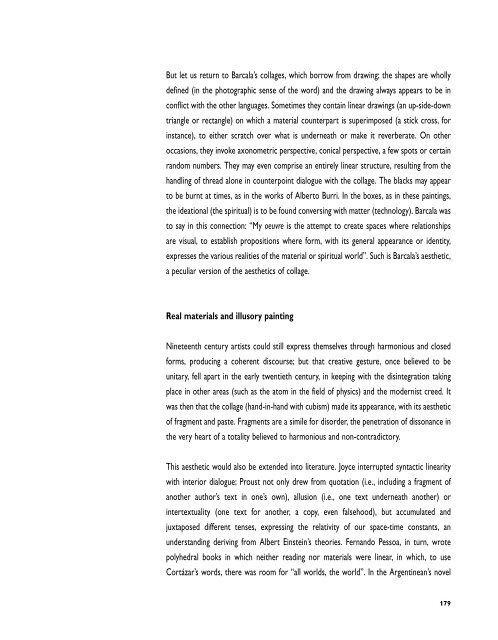Catálogo de la exposición - Fundación César Manrique
Catálogo de la exposición - Fundación César Manrique
Catálogo de la exposición - Fundación César Manrique
Create successful ePaper yourself
Turn your PDF publications into a flip-book with our unique Google optimized e-Paper software.
But let us return to Barca<strong>la</strong>’s col<strong>la</strong>ges, which borrow from drawing; the shapes are wholly<br />
<strong>de</strong>fined (in the photographic sense of the word) and the drawing always appears to be in<br />
conflict with the other <strong>la</strong>nguages. Sometimes they contain linear drawings (an up-si<strong>de</strong>-down<br />
triangle or rectangle) on which a material counterpart is superimposed (a stick cross, for<br />
instance), to either scratch over what is un<strong>de</strong>rneath or make it reverberate. On other<br />
occasions, they invoke axonometric perspective, conical perspective, a few spots or certain<br />
random numbers. They may even comprise an entirely linear structure, resulting from the<br />
handling of thread alone in counterpoint dialogue with the col<strong>la</strong>ge. The b<strong>la</strong>cks may appear<br />
to be burnt at times, as in the works of Alberto Burri. In the boxes, as in these paintings,<br />
the i<strong>de</strong>ational (the spiritual) is to be found conversing with matter (technology). Barca<strong>la</strong> was<br />
to say in this connection: “My oeuvre is the attempt to create spaces where re<strong>la</strong>tionships<br />
are visual, to establish propositions where form, with its general appearance or i<strong>de</strong>ntity,<br />
expresses the various realities of the material or spiritual world”. Such is Barca<strong>la</strong>’s aesthetic,<br />
a peculiar version of the aesthetics of col<strong>la</strong>ge.<br />
Real materials and illusory painting<br />
Nineteenth century artists could still express themselves through harmonious and closed<br />
forms, producing a coherent discourse; but that creative gesture, once believed to be<br />
unitary, fell apart in the early twentieth century, in keeping with the disintegration taking<br />
p<strong>la</strong>ce in other areas (such as the atom in the field of physics) and the mo<strong>de</strong>rnist creed. It<br />
was then that the col<strong>la</strong>ge (hand-in-hand with cubism) ma<strong>de</strong> its appearance, with its aesthetic<br />
of fragment and paste. Fragments are a simile for disor<strong>de</strong>r, the penetration of dissonance in<br />
the very heart of a totality believed to harmonious and non-contradictory.<br />
This aesthetic would also be exten<strong>de</strong>d into literature. Joyce interrupted syntactic linearity<br />
with interior dialogue; Proust not only drew from quotation (i.e., including a fragment of<br />
another author’s text in one’s own), allusion (i.e., one text un<strong>de</strong>rneath another) or<br />
intertextuality (one text for another, a copy, even falsehood), but accumu<strong>la</strong>ted and<br />
juxtaposed different tenses, expressing the re<strong>la</strong>tivity of our space-time constants, an<br />
un<strong>de</strong>rstanding <strong>de</strong>riving from Albert Einstein’s theories. Fernando Pessoa, in turn, wrote<br />
polyhedral books in which neither reading nor materials were linear, in which, to use<br />
Cortázar’s words, there was room for “all worlds, the world”. In the Argentinean’s novel<br />
179















![Becas y premios de la Fundación César Manrique [1997-2006]](https://img.yumpu.com/20766851/1/184x260/becas-y-premios-de-la-fundacion-cesar-manrique-1997-2006.jpg?quality=85)
